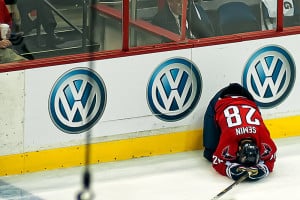DAVID KRAUSE
The Manitoban (University of Manitoba)

Alex Semin of the Washington Capitals after sustaining a head shot in this year's pre-season.
Rising concerns about concussions among children playing in youth hockey leagues has led to some ideas for reform — chiefly, raising the checking age. Dr. Martin Bunge, a paediatric radiologist at the Children’s Hospital in Winnipeg and Brian Foreman, a minor hockey coach for Manitoba’s Fort Garry Flyers, shared their expert opinions on the controversy.
Both Foreman and Dr. Bunge agree concussions seem to be rare in junior or minor hockey leagues.
“We don’t see many children with concussions, but that does not say that concussions don’t occur,” said Dr. Bunge. “The [minor] hockey league mandates that children wear helmets during hockey to protect their heads. Having said that, small concussions can occur.”
Foreman argues hitting will take place in hockey — it’s the nature of the sport — so responsible player contact must be taught to minimize the potential for injury.
“You also have to teach them, number one, how to hit responsibly and how to take a hit,” Foreman emphasized. “I think it’s the responsibility of coaches to teach [the players] at a younger age responsible ways to hit and more importantly how to take a hit and how not to put yourself in dangerous situations when you are in the game.
“[Checking] became a way to separate player from puck,” Foreman continued. “It’s also used strategically to change momentum in games… perhaps to take the player mentally out of the game — and that’s part of the game.”
Foreman contends the quality of modern hockey equipment doesn’t allow players to feel the hits and respond correctly.
“So you see sticks up, you see elbows up and again our job as a coach is to teach that properly and the techniques properly,” he said. “And at the grassroots level that will eventually carry up to when these kids are in junior and beyond. They will have respect for players and the game, and also they know that the hits are coming and how to respond.”
Dr. Bunge said a concussion is “a clinical diagnosis that is dependent on whether the child has loss of consciousness at the time and however long loss of consciousness occurs.”
“The concussions are sometimes picked up radiographically on an MRI session,” Dr. Bunge said “What we are looking for are tiny bleeds in the brain at the junction of the grey and white matter. They occur in very specific portions of the brain, in the frontal and temporal lobes, and these are the areas of the brain which determine personality and cognitive functions.”
Concussions can have long effects on the child’s health, he added.
“The problems that occur may not manifest themselves immediately other than post-concussion syndrome, which presents the children with headaches and generally not feeling up to things,” said Dr. Bunge. “Later on in life, however, children with post-concussion syndromes are more prone to degenerative diseases such as Alzheimer’s.”
Dr. Bunge states that there should be no checking or hitting in minor hockey as it is dangerous to the child and any risk should be avoided. He also commented that the age in which checking is introduced should be raised.
“I would recommend that they raise body checking to 15, 16 — if not older. I don’t think it has any place in sport,” he said.
Foreman disagreed with Dr. Bunge’s stance on raising the age at which checking is permissible, stating that it can be done safely at any age, as long as it is properly taught. But that doesn’t mean he is opposed to any changes.
“I really applaud the stance the NHL is taking on headshots, and hopefully that will filter down through the NHL and through the leagues,” said Foreman. “You need all players to play hockey, and if we keep hitting and hurting each other inappropriately, you will run each other out of the game.”
Hockey Canada has recently implemented rules and regulations that should help prevent concussions and properly treat them when they happen. New rules regarding head checking, hitting from behind, equipment fitting, and player/spectator conduct will be monitored and enforced during the 2011–12 female and minor hockey seasons.
—
Photo: Clydeorama/Flickr